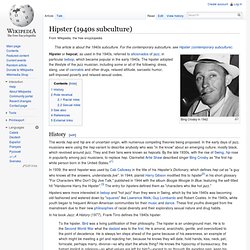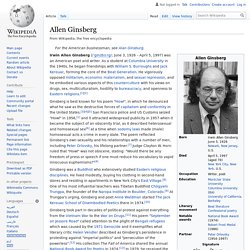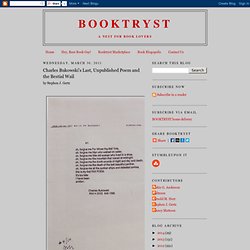

Friedrich Nietzsche. Hipster (1940s subculture) Bing Crosby in 1942 In 1939, the word hepster was used by Cab Calloway in the title of his Hepster's Dictionary, which defines hep cat as "a guy who knows all the answers, understands jive".

In 1944, pianist Harry Gibson modified this to hipster[2] in his short glossary "For Characters Who Don't Dig Jive Talk," published in 1944 with the album Boogie Woogie In Blue, featuring the self-titled hit "Handsome Harry the Hipster".[3] The entry for hipsters defined them as "characters who like hot jazz. " In his book Jazz: A History (1977), Frank Tirro defines the 1940s hipster: To the hipster, Bird was a living justification of their philosophy. The hipster is an underground man. Marty Jezer, in The Dark Ages: Life in the United States 1945–1960 (1999), provides another definition: In Lennie Tristano's view, the hipsters' relation to bebop was anything but positive: "the supercilious attitude and lack of originality of the young hipsters constitute no less a menace to the existence of bebop.
Allen Ginsberg. Irwin Allen Ginsberg (/ˈɡɪnzbɜːrɡ/; June 3, 1926 – April 5, 1997) was an American poet, philosopher, writer, and activist.

He is considered to be one of the leading figures of both the Beat Generation during the 1950s and the counterculture that soon followed. He vigorously opposed militarism, economic materialism and sexual repression and was known as embodying various aspects of this counterculture, such as his views on drugs, hostility to bureaucracy and openness to Eastern religions.[1] He was one of many influential American writers of his time known as the Beat Generation, which included famous writers such as Jack Kerouac and William S. Burroughs. Ginsberg was a practicing Buddhist who studied Eastern religious disciplines extensively. His collection The Fall of America shared the annual U.S.
Biography[edit] Early life and family[edit] Les Beats Hotels - William S. Burroughs. Lieu : Au 9 de la rue Git-le-Cœur, dans le 6ème arrondissement de Paris (France), entre la rue Saint André des Arts et le Quai Augustins. L’histoire : En 1933, M. et Mme Rachou, un couple de provinciaux, arrivent de Giverny, près de Rouen, et deviennent gérants de l’hôtel. Ils accueillent les artistes, les autorisent à vivre comme ils veulent., et à payer leur loyer avec leurs œuvres d’art. Mme Rachou gère le bistrot au rez-de-chaussée et la réception de l’hôtel. F.A.Z.-Romane der Woche: Der stillgestellte Mensch - Bücher der Woche. DeCavalcante crime family.
History Beginnings Although not recognized as an autonomous crime family until the regime of Simone DeCavalcante, there were several bosses in North Jersey during the Prohibition era controlling transportation of alcohol and whiskey into New York City.

In Newark, New Jersey, there was the Newark family headed by Gaspare D'Amico, the Reina family's Jersey crew controlled by Gaetano "Tom" Reina, the Masseria family's New Jersey faction and the Elizabeth family headed by Stefano Badami. In Newark, D'Amico controlled illegal gambling and bootlegging operations throughout the early 1920. In 1935, Vincenzo Troia a former associate of Salvatore Maranzano conspired to take over the Newark family and he was murdered.[4][5] Two years later in 1937, D'Amico fled the United States after a failed assassination attempt on his life order by Joseph Profaci. As Delmore kept running the organization before he became ill in the early 1960s, the rebellious times of New Jersey had finally ended. John Riggi. 11. Lama Chime Rinpoche. Der Ehrwürdige Lama Chime Rinpoche ist einer der vier inkarnierten Lamas (Tulkus) des Klosters Benchen in Osttibet.

Er lehrt in Übereinstimmung mit der Karma-Kagyu-Schule des Tibetischen Buddhismus. In Tibet studierte und praktizierte er buddhistische Meditation in der Tradition des großen Yogis und Dichters Milarepa (1052-1135), die als Mahamudra bezeichnet wird. Playing For Keeps. One day while I was rehearsing at the Mime Troupe, a lithe, freckled man with flinty, Irish features walked in to observe. He had an arresting gait with a leonine head thrust aggressively forward as if it were impatient with the body behind it.
His eyes were a cool, unflappable blue, his face a mask, suggesting abundant anger and determination. Emmett Grogan had come to audition. We struck up a conversation that carried us through the afternoon and a long walk back to our respective flats, which, it turned out, were on opposite corners of the same intersection of Fell and Steiner streets. He was a galvanizing story teller and an immediate new friend who subsequently changed my life in more profound ways then anyone I had ever met before, or have allowed to since. Officially, America was a land in love with itself, and its buoyant optimism and muscular self-confidence aroused the lusts and envy of the entire world.
The Richard Brautigan Archives : Emmett Grogan. Charles Bukowski's Last, Unpublished Poem and the Bestial Wail. By Stephen J.

Gertz On Friday, February 18, 1994, at 2:14 PM - eighteen days before his death - Charles Bukowski, America's poet laureate of society's fringe, sent to his publisher, John Martin of Black Sparrow Press, via FAX, what would be his last poem. oh, forgive me For Whom the Bell Tolls, oh, forgive me Man who walked on water,oh, forgive me little old woman who lived in a shoe, oh, forgive me the mountain that roared at midnight, oh, forgive me the dumb sounds of night and day and death, oh, forgive me the death of the last beautiful panther, oh, forgive me all the sunken ships and defeated armies, this is my first FAX POEM.
It's too late: I have been smitten. We wondered about it and asked John Martin for insight. "On February 18, 1994 Hank had a fax machine installed at his home. "I ran off nine photocopies of the fax, for a total of ten, and numbered and initialed them. He possessed, for once, a simple sense of joy. A personal thank you to John Martin Of related interest: The Haight-Ashbury Home Page - Community Website Since 1997 - Provided by SanFranciscoBay.com.